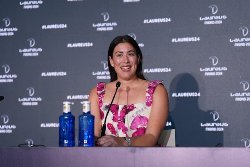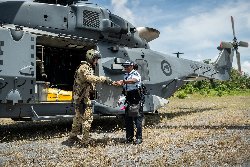Cablegate: Monitoring Visit to Ky Son Phase Ii Project
This record is a partial extract of the original cable. The full text of the original cable is not available.
UNCLAS SECTION 01 OF 04 HANOI 001043
SIPDIS
SENSITIVE
STATE FOR INL/AAE; EAP/BCLTV
E.O. 12958: N/A
TAGS: SNAR PREL PGOV EAID LA VM UNODC CNARC
SUBJECT: MONITORING VISIT TO KY SON PHASE II PROJECT
REF: 01 Hanoi 3262
1. (SBU) SUMMARY. Much to the relief of district
officials and following extensive delays, the UNODC-funded
Ky Son Phase II is up and running. Agriculture and
livestock models -- the focus of the USG assistance to this
project -- are being implemented in a number of communes
dispersed around the district. The selection process for
those benefiting from the project is unclear, however. The
inventory control system currently in place is also not an
effective management tool. UNODC is aware of these problems
and is attempting to address them, a process complicated by
the new national project execution. Septel will report on
developments in and around the district's Nam Can border
crossing. END SUMMARY.
2. (U) At the invitation of the United Nations Office of
Drugs and Crime (UNODC -- formerly UNDCP), poloff and pol
FSN visited Ky Son district in Nghe An Province April 21 -
24. (Embassy very much appreciates INL funding for this
travel.) Ky Son, which borders Laos, is one of the poorest
districts in one of Vietnam's poorest provinces. It is
about a 10-hour drive from Hanoi. Ky Son's population is
about 60,000, nearly all ethnic minorities (mainly Hmong and
Kho Mu). Until 1993, approximately 1,000 hectares of opium
poppy were grown in the district. Cultivation has been
essentially eliminated in Ky Son except in a few remote
locations. However, according to UNODC, there is "anecdotal
evidence" that local Ky Son farmers are cultivating opium on
the Lao side of the border for consumption and sale in
Vietnam.
3. (U) The visit included meetings with provincial and
district authorities as well as observation of about 10
separate crop substitution and alternative development
activities in four different communes located in various
areas of Ky Son district. Activities visited included
raising livestock (pigs) and "black" chickens as well as
cultivating fruit trees (peach and plums), mushrooms, tea,
terrace rice, and hybrid Chinese (flatland) rice. Some
activities were continuations of those begun under Phase I,
which finished in February 2001; others are new under Phase
II. Officially titled "Capacity Building for Alternative
Development to replace Opium Poppy Cultivation," the project
was scheduled to begin January 2002. Actual project
implementation began in July 2002 (see paras 7 and 8 for
reasons for this delay).
----------------
DISTRICT SUPPORT
----------------
4. (U) At Mung Xem, the Ky Son district capital, People's
Committee Chairman Mua No Tu stated that the people in his
district had "benefited greatly" from the project and "are
happy" that, after a long delay, Phase II was up and
running. He expected Phase II would be "as successful as
Phase I." Implementing Phase II meant that UNODC and the
donor community were "still committed" to making the area
free from opium poppy cultivation, he noted. However, he
lamented that a "small amount" of poppy recultivation had
occurred this past year in a remote area in the southwestern
part of the district, but claimed that authorities had
"quickly eradicated it." Other communes were "very much
looking forward" to new project activities, he added. Tu
said that at a project review meeting among all relevant
parties scheduled for "sometime" in May in Hanoi, the
district and authorities from the Ministry of Agriculture
and Rural Development (MARD) plan to ask for a project
extension (with no additional funds) because to the "late
start" for implementation.
5. (U) According to Nguyen Xuan Phuong, the Phase II
onsite project manager, Phase II will implement project
models in 16 of Ky Son's 20 communes. According to UNODC's
technical advisor, Per Vogel, this is "very ambitious,"
considering the logistics involved and the weak
infrastructure in most parts of the district. However, if
the project is indeed extended, it would be possible to
reach more communes, he predicted.
--------------------------------------
LESS UNODC CONTROL - SUBSEQUENT DELAYS
--------------------------------------
6. (U) According to Vogel, a key feature of Phase II is
that the GVN assumed management control for most of the
project's components. The major exception is in the area of
personnel and administration, which is essentially Vogel's
responsibility. Vogel, a former UNODC program officer, was
also involved with Phase I. Under Phase II, he is a
contract employee based in Hanoi. He said that he travels
to Ky Son "about two or three times" per quarter.
7. (SBU) The GVN's request to change the project's
modality to national project execution ("NEX") came as a
"surprise" to UNODC and made the original project document
"somewhat obsolete," according to Vogel. As a result of
this request, it was impossible to transition quickly from
Phase I and "some momentum" was lost, he admitted. In
addition, MARD's national project director insisted on
hiring an onsite project manager whom he knew personally.
The appointment was a "disaster," Vogel claimed. Firing and
replacing the national project manager also cost "a few
months," he admitted. Vogel said that he was unsure why the
request to change to NEX came up so suddenly, but he opined
that national authorities "might have looked" at UNDP, where
he claimed most projects are NEX. (Note: An NGO source who
has worked in the Ky Son area told poloff on April 25 that
UNDP is "reevaluating NEX" in light of implementation and
accountability problems on "several projects." End Note.)
8. (SBU) Another issue delaying implementation involved
the hiring of "specialists" tasked with acting as advisors
to villages for the various components of the project. The
pool of applicants was greatly reduced, according to Vogel,
because UNODC required the candidates to have a high level
of English. Several of the specialists hired in May 2002
have underperformed, according to Vogel; when their
contracts expire in May, they will not be renewed. Vogel
concluded that that the English language requirement was
"unrealistic." Previously, UNODC required specialists to
write their reports in English; that will no longer be the
case -- specialists under the new contract will write their
reports in Vietnamese and the reports will then be
translated into English by the project's Hanoi office.
--------------------------
SELECTION PROCESS PROBLEMS
--------------------------
9. (U) Most of the households poloffs visited appeared to
have some sort of official connection that resulted in their
participation in the project. Many were vague about exactly
how they were selected (e.g., "officials contacted me"). A
few said that they had previously received benefits from
Phase I; those appeared relatively prosperous.
10. (U) At Huoi Tu commune, about 10 miles northeast of
Mung Xem, poloffs visited a tea nursery model supported by
the project. The objective of the model is to introduce a
higher-quality tea in the region. He could not say how many
or which family households would eventually benefit from the
project.
11. (U) In Tac Ca commune, about five miles west of Mung
Xem, poloffs visited a newly installed pigsty. The
household had received cement from the project to build the
sty, as well as several sows. The person in charge of the
pigs admitted that he did "knew very little" about pigs but
that his son, the village chief, had asked him to look after
them. In Hui Kiem commune, about six miles southeast of
Mung Xem, the project is assisting a woman to grow
mushrooms. She said that while she had been helped with a
similar project in Phase I, that crop had "failed."
Subsequently, she reapplied and "the authorities decided to
help me again." Subsequently, the woman admitted that she
was the chairperson of the commune farmers' association.
12. (U) In Muong Long commune, about 20 miles northeast of
Mung Xen, poloffs visited a relatively prosperous three
hectare farm that consisted of plum and peach trees, a few
other crops such as corn, and a well-tended chicken coop.
The farmer said that he had received tree graftings from
neighbors who had originally received peach trees (imported
from Australia and France) during Phase I. He said that he
was "looking forward" to receiving more trees in Phase II.
Project manager Phuong explained that this household had
"shown much initiative" during Phase I and proved that that
project could be successful with an individual who had once
grown poppy on his land. Therefore, "authorities" decided
he should receive additional assistance under Phase II.
Phuong also claimed that the project wanted to implement
project models among households that had a "good chance to
succeed."
13. (SBU) In Huu Kiem commune, about 7 miles southeast of
Mung Xem, poloffs visited a relatively large complex
containing several fishponds, a pigsty, a chicken coop, and
crops, including corn and vegetables. While these
activities were not project-supported, the farmer said that
he was "expecting" the project to provide new fish for the
fish ponds. The farmer said that he had recently moved to
the complex and had agreed to make rent payments totaling
VND 14 million (about USD 980) for the next year to the
district Agriculture and Forestry department to use the
property. He had also recently purchased 65 sows for about
VND 500,000 each (about USD 35). The farmer said he was
expecting to receive fish from the project to stock the
ponds. When asked how he managed to pay the rent and buy
the livestock, he replied "through my savings." (Comment:
In a poor area such as this one, having sufficient savings
to pay rent and buy livestock from savings would seem highly
unlikely. End Comment.) Subsequent questioning revealed
that the "tenant" was the head of the local farmer's union.
Vogel said that based on what he had seen at this site, he
would inform the project management that funds should go to
someone more in need because this individual already
appeared well-established and the farmer appeared to be
benefiting from official connections. He speculated that
the capital might have come (at least indirectly) from other
donors active in the district.
14. (SBU) Subsequent to the field visits, Vogel admitted
that the selection process "was not working the way I would
like." He lamented that his ability to influence the
process was "limited" due to NEX and the need for him to
spend the majority of his time in Hanoi. Despite a district-
wide "needs assessment" carried out during the early stages
of Phase II implementation as well as provisions for
participatory selection, he agreed that the selection
process "left much to be desired in terms of transparency."
Vogel lamented that based on his observations during the
field visit, it appeared that the authorities "were not
paying much attention" to the criteria for participation.
He said he would meet with officials to try to push for a
more balanced approach; however, he cautioned that NEX
limits his influence in the process.
----------------------------------------
INVENTORY CONTROLS - NOT A CLEAR PICTURE
----------------------------------------
15. (U) According to project manager Phuong, normally
there is not much expendable equipment around the UNODC
project house. As project material comes in, it is
generally moved out to the project areas quickly. The
current inventory system is not a "living document" -
despite Vogel's requests, the project secretary (who is
responsible for inventory control) had not updated the list
for nearly a year. A spot check of a few items showed some
discrepancies between on hand counts and the inventory. The
motorpool supply area was supposed to have 29 Toyota filters
for various UNODC vehicles according to the inventory, but
there were only 19 on hand when the secretary counted.
Eventually, he was able to account for them through "stock-
in" and "stock-out" forms, but this required about an hour's
work with the files. Similarly, we counted 316 hydro
generators stored in three locations. These were not even
inventoried because they were "too new," according to the
secretary. After scouring several files, he was able to
SIPDIS
account for 300 of the generators through various receipts.
The secretary claimed the remaining 16 had been returned to
the vendor for various reasons, but he could not produce
documentation to support this claim.
16. (U) On the non-expendable side, inventory documents
indicated about 20 Minsk motorbikes were intended for
project-related activities in the district. However, the
inventory listed their locations as "communes." Since there
are 180 villages in 20 communes scattered around Ky Son
district, this did not provide a very precise location. No
project officials could say with certainty where these
motorbikes were located or how they were being used. At an
outbrief on April 23, Vogel and project manager Phuong
pledged that they would update the inventory, keep it
current, and endeavor to account for non-expendable property
during field visits.
17. (U) Subsequent to our visit, UNODC provided a summary
copy of the outside auditor's report for calendar year 2002.
The report recommended that, "project management should
enhance control and monitoring over the project's non-
expendable property."
-------
COMMENT
-------
18. (SBU) Officials and the local population appear
committed to fighting drugs and very pleased that Phase II
is being implemented. By all appearances, Phase I helped
contribute both to the virtual elimination of opium poppy
cultivation and to a general increase in the standard of
living in parts of the district. Theoretically, UNODC's
checks and balances in NEX should provide assurances that
project implementation will proceed according to plan;
however, questions remain regarding the transparency of
project participation and accountability for project
material, issues about which UNODC is now even more clearly
aware and attempting to address.
BURGHARDT


 UN News: Healing Page By Page In Earthquake-affected Türkiye
UN News: Healing Page By Page In Earthquake-affected Türkiye Save The Children: Rate Of Attacks On Healthcare in Gaza Higher Than In Any Other Conflict Since 2018
Save The Children: Rate Of Attacks On Healthcare in Gaza Higher Than In Any Other Conflict Since 2018 UN News: Green Light For New Cholera Vaccine, Ukraine Attacks Condemned, Action Against Racism
UN News: Green Light For New Cholera Vaccine, Ukraine Attacks Condemned, Action Against Racism Laureus: Grand Slam Champion Garbiñe Muguruza Announces Retirement Ahead Of Laureus World Sports Awards
Laureus: Grand Slam Champion Garbiñe Muguruza Announces Retirement Ahead Of Laureus World Sports Awards Carbon Market Watch: Going For Green - Is The Paris Olympics Winning The Race Against The Climate Clock?
Carbon Market Watch: Going For Green - Is The Paris Olympics Winning The Race Against The Climate Clock? New Zealand Defence Force: NZDF Working With Pacific Neighbours To Support Solomon Islands Election
New Zealand Defence Force: NZDF Working With Pacific Neighbours To Support Solomon Islands Election